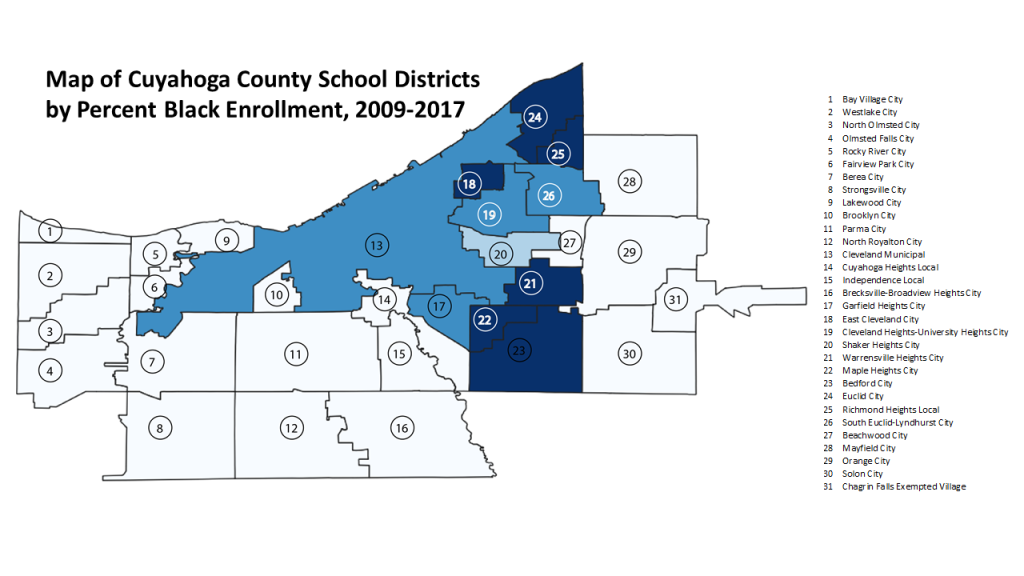This data was collected for use in Beth Fry’s MPA Thesis “Racial Imbalance Between Communities and Public Schools in Cuyahoga County, Ohio: Non-Hispanic Whites Opting Out Amid Rising Black Enrollments.” All statistics, calculations, and figures were done by Ms. Fry using data from the National Center for Information Statistics–particularly from the Common Core of Data and Education Demographic & Geographic Estimates.

White families residing in school districts of Cleveland’s east side inner-ring suburbs are opting out of public schools at rates higher than the City of Cleveland. Three out of 4 white families living in the Euclid, East Cleveland, Richmond Heights, South Euclid, Cleveland Heights, Maple Heights, and Warrensville Heights school districts are opting out the local public schools in 2017; Shaker Heights and Garfield Heights are the only ones near 50 percent. Compare this to the east side outer-ring suburbs and less than half of white families opt-out of the public schools. The entire west side, meanwhile, has opt-out rates well below 40 percent. Though the county average sees only 1 out of every 2 white families not using their zoned public school district, the numbers on the east inner-ring and City of Cleveland skews the data heavily. Why might that be?

The answer is fairly simple: large numbers of black students enrolled. White parents who live in districts with at least a plurality of black students will more than likely choose an alternative education option for their children–most notably, private school. Indeed, Ms. Fry found–using a linear regression model–that for every 2 black students that enrollment in a public school district, 1 white student exits. The districts with the highest white opt-out rates in the county also have the highest proportions of black students. While only 31 percent of public school students in Cuyahoga County are black, they account for 67 percent of Cleveland Municipal’s enrollment and 77 percent for those on the inner-ring east side.


South Euclid-Lyndhurst is in an interesting position because its shift from predominantly white to predominantly black has all occurred in the past twenty years. Only three other districts of the County’s 31 have experience the same shift in the same period: Euclid, Richmond Heights, and Garfield Heights. This can best be seen in the “cross-hatching” pattern that occurs when assessing black enrollments and white enrollments in SEL in a bar graph. These two groups were at near parity in 2006 and have quickly diverged in the last 14 years.

The proportion of white families opting out of the South Euclid-Lyndhurst School District reached its lowest point in the past decade in 2011 at 64 percent–indicating that, at the bare minimum, two out of every three white school-aged children in South Euclid and Lyndhurst did not attend the public schools. Two spikes of five percentage points–the biggest jumps in this period–occurred between 2012 & 2013 and then again between 2015 & 2016. Today, only 20 percent of white school-aged children are enrollment in the district. Again, this is tied to increasing numbers of black enrollment.

Our overall goal is to bring to light the whispered truth that exists in South Euclid and Lyndhurst: that if you’re white and have the means, you don’t send your child to the local public schools. We want to push back on this narrative, counter it with information, and start a dialogue that helps us to dismantle this practice of white supremacy. Public schools are for the children of a community–all of them.

Is the goal to keep middle-class families from enrolling their children in the public schools? or keep families enrolling?
LikeLike
We are a pro-public schools organization! Our data suggests that over the past 15 years, there has been declining middle class support for our community’s public schools and our goal is to reverse this trend.
LikeLike